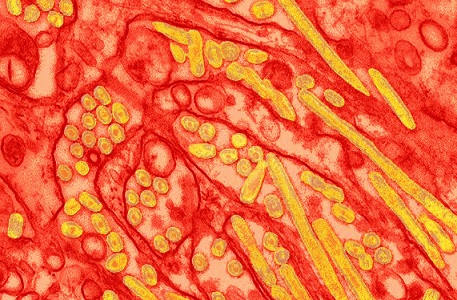Nikhil Prasad Fact checked by:Thailand Medical News Team Dec 15, 2024 3 months, 4 weeks, 1 day, 2 hours, 46 minutes ago
Medical News: A potential human case of bird flu, also known as H5N1, has been reported in Louisiana, marking the first known instance in the state. The Louisiana Department of Health announced that the affected individual, a resident of southwestern Louisiana, is currently hospitalized after exposure to sick and dead birds suspected of carrying the virus. This alarming development highlights ongoing concerns about the transmission of H5N1 from animals to humans, although public health officials emphasize that the overall risk to the general population remains low.
 Louisiana Reports First Possible Human Case of H5N1
Louisiana Reports First Possible Human Case of H5N1
This
Medical News report will delve into the details of the case, the broader implications of the bird flu outbreak in the United States, and measures individuals can take to protect themselves. The U.S. Centers for Disease Control and Prevention (CDC) is working closely with Louisiana health authorities to confirm the diagnosis and investigate the circumstances of the exposure.
Growing Concern Over H5N1 Infections in the US
The Louisiana case is part of a concerning trend involving the H5N1 virus, which has been spreading among birds and occasionally infecting humans. As of December, the United States has reported 60 human cases of H5N1, with most linked to close contact with infected poultry or dairy cows.
https://www.cdc.gov/bird-flu/situation-summary/index.html
These cases include 35 in California, 14 in Washington, and smaller numbers in other states such as Colorado, Arizona, and Michigan. This year alone, the global tally of human H5N1 cases has reached 82, including instances in countries like Canada, Cambodia, and Vietnam.
The Louisiana Department of Health has confirmed that the individual had direct exposure to sick and dead birds, highlighting the primary mode of transmission for the virus.
https://ldh.la.gov/news/H5N1-2024
However, two U.S. cases - one in California and one in Missouri - have no known links to poultry or dairy, raising questions about possible alternate transmission routes. Public health officials continue to stress that there is no evidence of human-to-human transmission of H5N1 in the United States.
The Role of Emerging Strains
The strain involved in the Louisiana case is suspected to be clade 2.3.4.4b, a variant of H5N1 that has shown increased transmissibility in mammals. This variant has been detected in many of the reported cases across the U.S., Canada, and other affected countries. The potential for mutations that might allow easier transmission between humans remains a concern among researchers.
H5N1 has been infecting dairy cows in the U.S. since the spring. As of Friday, the outbreak had spread to 845 dairy herds in 16 states, according to the Agriculture Department. The vast majority of those herds are in California.
phis.usda.gov/livestock-poultry-disease/avian/avian-influenza/hpai-detections/hpai-confirmed-cases-livestock">https://www.aphis.usda.gov/livestock-poultry-disease/avian/avian-influenza/hpai-detections/hpai-confirmed-cases-livestock
Health officials and scientists from institutions such as the U.S. CDC, the U.S. Department of Agriculture (USDA), and state health agencies are closely monitoring these developments. Recent studies have indicated that while pasteurized milk supplies in the U.S. are free from infectious bird flu viruses, raw milk has shown traces of the pathogen. This underscores the importance of food safety measures in preventing zoonotic diseases.
Symptoms and Risk Factors
Human cases of bird flu have generally been mild, with symptoms including conjunctivitis (pinkeye) and mild respiratory issues. No deaths have been reported in the U.S., although a Canadian teenager recently required hospitalization after severe illness from H5N1. In Louisiana’s case, details about the patient’s symptoms have not been disclosed.
Farmworkers and individuals who have direct contact with infected birds or dairy animals are at higher risk of contracting the virus. The CDC has also identified asymptomatic infections among farmworkers, suggesting that the true number of cases may be underreported.
Preventive Measures
To reduce the risk of infection, the Louisiana Department of Health has issued the following guidelines:
-Avoid direct contact with sick or dead birds and animals.
-Do not bring sick wild animals into your home.
-Ensure pets are kept away from dead animals and their droppings.
-Always cook poultry, eggs, and animal products thoroughly.
-Avoid consuming raw or unpasteurized dairy products.
Farmworkers and individuals exposed to birds or dairy animals are advised to consider seasonal flu vaccines to minimize the risk of co-infection with avian and human influenza strains.
Recent research has shed light on the zoonotic potential of the H5N1 virus. Studies have found that the virus can survive in raw milk, although pasteurization effectively neutralizes it. The USDA has ramped up testing efforts to monitor for bird flu in dairy herds and ensure the safety of the nation’s food supply.
Moreover, a November report by the U.S. CDC revealed evidence of asymptomatic infections in farmworkers, suggesting that mild or undetected cases could be more common than previously thought.
https://www.cdc.gov/mmwr/volumes/73/wr/mm7344a2.htm?s_cid=mm7344a2_w
Globally, the H5N1 virus has caused significant mortality in wild birds and sea mammals, with Peru reporting the deaths of over 500 sea lions and 55,000 birds. These incidents underscore the far-reaching impact of avian influenza on wildlife and ecosystems.
Conclusion
The emergence of Louisiana’s first human case of H5N1 bird flu is a reminder of the persistent threat posed by zoonotic diseases. While the risk to the general public remains low, the increasing prevalence of the clade 2.3.4.4b variant in animals and humans warrants vigilance. Public health agencies must continue to monitor for signs of human-to-human transmission and enhance preventive measures to limit the virus’s spread. Individuals, especially those working with birds or dairy animals, should adhere to safety guidelines and report any symptoms to healthcare providers promptly.
For the latest H5N1 News, keep on logging to Thailand
Medical News.
Read Also:
https://www.thailandmedical.news/news/vietnam-reports-18-year-old-male-being-infected-with-h5n1-avian-flu
https://www.thailandmedical.news/news/h5n1-bird-flu-adaptation-in-cats-in-south-dakota-as-a-lethal-neurotrophic-virus-raises-alarms
https://www.thailandmedical.news/articles/h5n1-avian-flu
